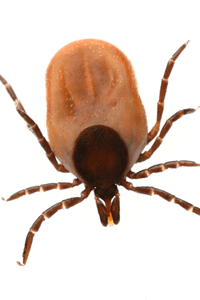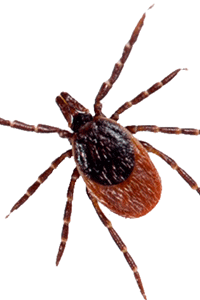How does Lyme disease affect humans?
Lyme disease is transmitted (passed on) to humans through the bite of an infected blacklegged tick (deer tick).1 The transmission cycle (how the bacteria is passed) begins when ticks feed on birds and small mammals that carry Lyme disease. Once the tick bites an infected animal, it becomes infected with Lyme disease and could possibly transmit the bacteria to humans through a bite.
A tick can transmit infection after being attached for 24 hours or longer, because it takes time for the bacteria to travel from the tick’s gut into its salivary glands.1 It is important to check for ticks and quickly remove them in order to prevent Lyme disease.1 If a blacklegged tick has Lyme disease but is removed right away, it is unlikely that infection will be passed on.
What are ticks?
Ticks are closely related to spiders. They're very small (1 to 5 mm) when unfed, and cannot fly or jump. They're usually found around the edges of trails, tall grass or bushes.
The most common types of ticks found in Middlesex-London are dog ticks and blacklegged ticks. NOTE: Lyme disease can only be transmitted through blacklegged ticks. In the Middlesex-London region, dog ticks are more commonly found than blacklegged ticks. Learn more →
Where are blacklegged ticks found?
Blacklegged ticks can be found almost everywhere in Ontario. They are known to feed on migratory birds, and as a result, they are found mainly along the routes that birds fly and can travel throughout the province.1
What are we doing about Lyme disease in Middlesex-London?
The Middlesex-London Health Unit follows up on human Lyme disease cases. The Health Unit looks for blacklegged ticks to find out whether or not Lyme disease is in the area. The Health Unit monitors ticks by having the public submit any ticks that they find to the Health Unit, and by going out to look for ticks in wooded or grassy areas where ticks might be found. When ticks are found, they are identified in the laboratory. Learn more about tick surveillance.
Additional Information
For more information about Lyme disease, please visit the Government of Canada or Public Health Ontario.
For more information about Lyme Disease, please contact the Vector-Borne Disease team at:
 Prevention and Personal Protection
Prevention and Personal Protection Ticks in Middlesex-London
Ticks in Middlesex-London Tick Identification
Tick Identification